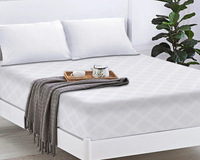Main Blog

Choosing the Perfect Printed Rug for Each Room: Size and Material Guide
A well-chosen printed rug can completely transform a room's look and feel. Whether you’re looking to add warmth to your bedroom, define a seating a...

Are Terry Fabric Mattress Protectors Breathable?
Have you ever woken up in the middle of the night feeling uncomfortably hot and clammy, even when your room temperature is just right? If so, your ...

Secret to Extending the Life of Your Luxury Mattress
There’s something truly special about sinking into a plush, luxury mattress at the end of a long day. It’s more than just a bed—it’s your sanctuary...

How Can The Right Shower Mat Keep Your Bathroom Floor Dry?
The bathroom, often considered a haven for rest and self-care, can also be a location of unanticipated dangers, particularly at moisture control. A...

10 Stunning Ways to Style a Geometric Printed Rug for a Chic & Modern Home
A geometric printed rug is more than just a floor covering—it’s a statement piece that adds personality, depth, and charm to your home. Whether you...

What Time of Year Is Best to Buy a Mattress?
When investing in a mattress, timing can make all the difference. Is there a particular time of year better for buying a mattress? The short answer...

How to Make Up a Bed and Breakfast Bed?
Welcome to our guide on how to make up a bed and breakfast bed! Whether you’re a B&B owner aiming to impress your guests or simply want to elev...

Should You Wash Bedding Before First Use?
When you buy new bedding, the excitement of fresh linens and the promise of a good night’s sleep can be tempting. However, one crucial question is ...

What You Need To Know About Adding A Thick Shag Rug To Your Home
In general, the pile on a shag rug will be lengthy, irregular, and even rather voluminous. Synthetic yarns with long, irregular strands create the ...

How to Create a Boutique Hotel-Style Bedroom at Home?
Do you ever wish you could capture the luxurious feel of a boutique hotel in your bedroom? Imagine walking into your personal space and being greet...


